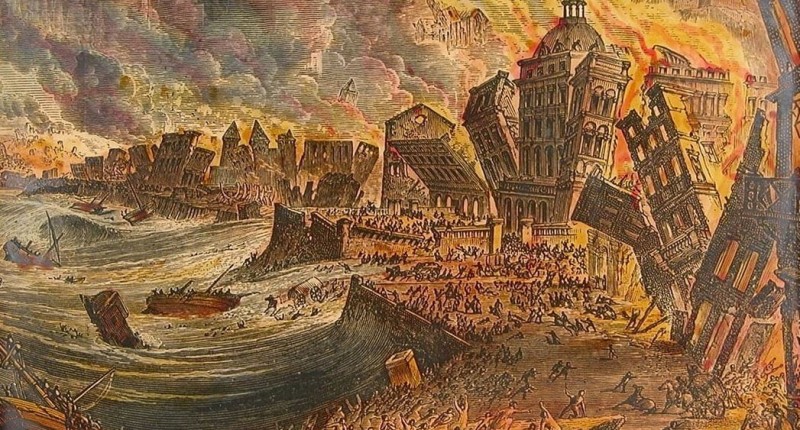
Introduction
The Great Lisbon Earthquake of 1755 was a catastrophic event that shook the city of Lisbon, Portugal, to its core. This powerful earthquake, combined with subsequent fires and a tsunami, caused widespread destruction, loss of life, and had profound societal and philosophical effects. In this article, we will delve into the details of the earthquake, explore its impact on Lisbon and beyond, and discuss how it shaped the course of history.
The Magnitude of Destruction
The Great Lisbon Earthquake was one of the most powerful earthquakes ever recorded in Europe. It struck on the morning of November 1, 1755, All Saints' Day, with an estimated magnitude of 8.5-9.0 on the Richter scale. The initial shock lasted for several minutes, causing buildings to collapse, streets to crack open, and people to be thrown off balance.
The Sequence of Events
The earthquake was followed by a series of devastating events that compounded the destruction. Within minutes of the quake, fires broke out throughout the city, fueled by the many candles lit for religious observances. The fires raged for several days, reducing large parts of Lisbon to ashes. As if that wasn't enough, a massive tsunami struck the coast, adding further devastation to an already shattered city.
Societal Impact and Rebuilding Efforts
The destruction caused by the Great Lisbon Earthquake was immense. Tens of thousands of people lost their lives, and the city's infrastructure was in ruins. The Portuguese government faced the daunting task of rebuilding the city and restoring order. Marquis of Pombal, the prime minister at the time, took charge of the reconstruction efforts. He implemented new building codes and urban planning measures that not only aimed to restore the city but also to make it more resistant to future disasters.
Philosophical Reflections
The earthquake raised profound philosophical questions and challenged the prevailing religious and philosophical beliefs of the time. Many wondered how such a devastating event could occur in a city known for its piety. The earthquake also prompted philosophers and theologians to question the concept of a benevolent and all-powerful God in the face of such natural disasters.
Scientific Advancements
The Great Lisbon Earthquake marked a turning point in the scientific study of earthquakes. It sparked interest among scientists, not only in Portugal but across Europe, to investigate and understand the causes and effects of seismic activity. This event led to advancements in seismology and earthquake engineering, laying the foundation for future research in the field.
Artistic and Literary Responses
The earthquake and its aftermath inspired artists and writers to capture the horror and devastation in their works. Painters such as Francisco Goya and writers like Voltaire incorporated the earthquake into their art, reflecting the profound impact it had on society and the human psyche. These creative expressions helped shape the narrative surrounding the earthquake and influenced public opinion.
Religious and Spiritual Considerations
The Great Lisbon Earthquake had a significant impact on religious beliefs and practices. It challenged the notion of divine intervention and sparked theological debates about the nature of God and the existence of evil. The event led to a decline in religious fervor in some quarters while also prompting new interpretations of faith and spirituality.
The Lisbon Earthquake and European Enlightenment
The earthquake coincided with the European Enlightenment, a period marked by a shift towards reason, rationality, and scientific thinking. The disaster in Lisbon served as a catalyst for intellectual discussions about the nature of natural disasters, human suffering, and the role of government in responding to crises. These discussions contributed to the development of Enlightenment ideas that shaped the political and social landscape of Europe.
The Modern-Day Legacy
The Great Lisbon Earthquake left an indelible mark on the city and its people. Today, visitors to Lisbon can still see the remnants of the earthquake, such as the ruins of the Carmo Convent, which serves as a haunting reminder of the disaster. The earthquake also served as a wake-up call for cities around the world to prioritize earthquake-resistant infrastructure and disaster preparedness.
Conclusion
The Great Lisbon Earthquake of 1755 was a seismic event that forever changed the course of Lisbon's history. Its destructive power not only led to widespread death and destruction but also had far-reaching societal and philosophical consequences. The earthquake challenged prevailing beliefs, sparked scientific advancements, and influenced art, literature, and religious thought. The legacy of the earthquake serves as a reminder of the resilience of humanity in the face of natural disasters and the transformative power of such events.
The Glass Armonica: Unveiling the Enchanting Sounds of Glass Music
Rupee Charges Ahead: Indian Currency Surges 6 Ps USDollar, Reflecting Investor Confidence
23 Airports Set for Major Upgrades to Boost Traffic and Elevate Travel Experience